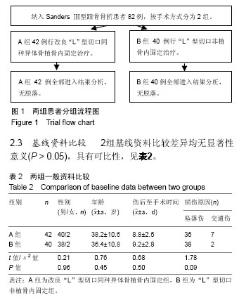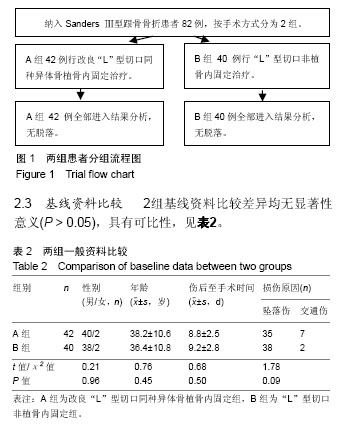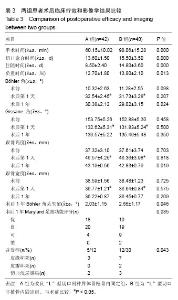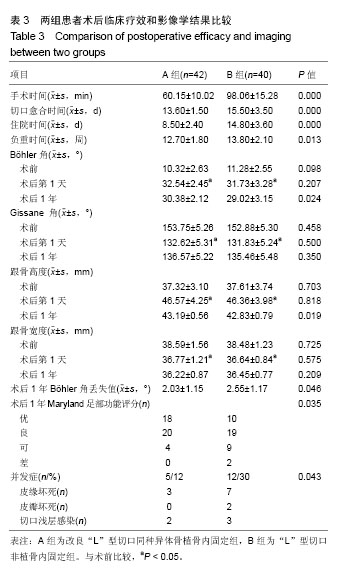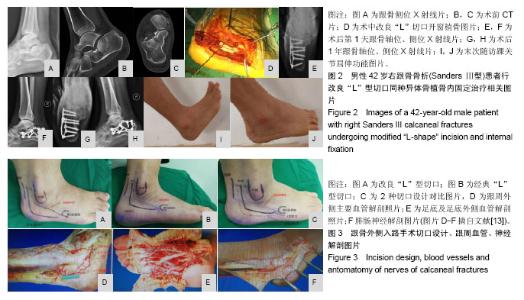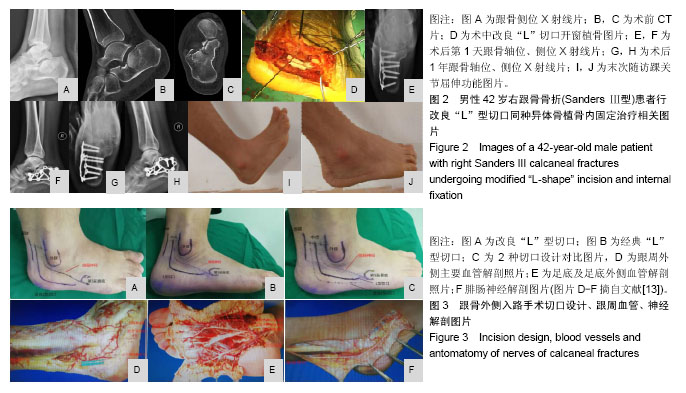| [1] Wallin KJ, Cozzetto D, Russell L,et al.Evidence-based rationale for percutaneous fixation technique of displaced intra-articular calcaneal fractures: a systematic review of clinical outcome. J Foot Ankle Surg. 2014;53(6):740-743.[2] Epstein N, Chandran S, Chou L. Current concepts review: intraarticu-lar fractures of the calcaneus. Foot Ankle Int. 2012;33(1): 79-86.[3] Buckley R, Tough S, McCormack R, et al. Operative compared with nonoperative treatment of displaced intra-articular fractures: a prospective, randomized, controlled multicenter trial. J Bone Joint Surg Am. 2002;84:1733-1744.[4] Sanders R. Displaced intra- articular fractures of the calcaneus. Bone Joint Surg (Am). 2000;82: 225-250.[5] Barei DP, Bellabarba C, Sangeorzan BJ, et al.Fractures of the calcaneus. Orthop Clin North Am. 2002;33(1):263 285.[6] 陈小亮,叶哲伟,刘建湘,等. 开窗直视下联合复位内固定治疗跟骨骨折[J].临床骨科杂志,2014,17(5):583-586.[7] 杨振军,何新泽,孙勃,等.改良“L”型切口治疗跟骨骨折疗效及并发症相关因素研究[J].中国矫形外科杂志,2015,23(12): 1123-1126.[8] 徐建民,于超.改良外侧“L”型切口与传统“L”型切口治疗跟骨骨折的比较研究[J].中国矫形外科杂志, 2013,21(22):2313-2316.[9] Burdeaux BD Jr.Fractures of the calcaneus:open reduction and internal fixation From the medial side-a 21-year prospective study.Foot Ankle Int. 1997;18:685-692. [10] Tennent TD,Calder PR,Salisbury RD,et al.The operative management of displaced intra-articular fractures of the calcaneum: a two-centre study using a defined protocol. Injury. 2001;32(6): 491-496.[11] Allmacher D,Gallen KS,Marsh J.Intra-articular calcaneal fractures treated non-operation and followed sequentially for 2 decades. J Orthop Trauma. 2006; 20(7): 464-469.[12] 朱炼. 跟骨周围神经、血管的体表投影测量及其临床意义[D].石家庄:河北医科大学,2007.[13] 章鸣. 异位保存离体足跟皮瓣再回植技术修复足跟软组织缺损的临床研究[D].苏州:苏州大学,2010.[14] 黄远清,杨福周,易远历,等.足背外侧血管神经的解剖及足背外侧逆行筋膜蒂皮瓣的临床应用研究[J].中国医学创新,2017,14(17):18-22.[15] Shin TM, Bordaux JS. How suture technique affects the cosmetic outcome of cutaneous repairs. J Drugs Dermatol. 2014;13(8):967-969.[16] Cao H, Li YG, An Q, et al. Short-term outcomes of open reduction and internal fixation for sanders type iii calcaneal fractures with and without bone grafts. J Foot Ankle Surg. 2018;57(1):7-14.[17] 顾世勤,方毅,萨晨琛,等.切开复位内固定植骨与不植骨治疗移位型跟骨关节内骨折的Meta分析[J].中国骨与关节损伤杂志,2017,32(12): 1270-1274.[18] Duymus TM,Mutlu S,Mutlu H,et al. Need for bone grafts in the surgical treatment of displaced intra-articular calcaneal fractures. J Foot Ankle Surg. 2017;56(1):54-58.[19] Liang J,Cao HB, Xin JY. Therapeutic efficacies of bone grafng for calcaneal intra-calcaneal fractures. Zhonghua Yi Xue Za Zhi. 2012; 92(3):197-199.[20] 许云,陈康. 一期人工植骨内固定治疗关节内压缩性跟骨骨折的疗效观察[J].临床急诊杂志,2013,14(8):381-382. [21] 马腾,谭力,朱亮亮,等.闭合性Sanders Ⅲ-Ⅳ型跟骨骨折植骨内固定手术的远期随访[J].中外医学研究,2013,11(31):25-27.[22] Müller SA, Barg A, Vavken P,et al.Autograft versus sterilized allograft for lateral calcaneal lengthening osteotomies Comparison of 50 patients.Medicine (Baltimore). 2016;95(30):e4343. [23] Devrier JG, Scharer B. Comparison and use of allograft bone morphogenetic protein versus other materials in ankle and hindfoot fusions. J Foot Ankle Surg. 2018. S1067-2516(17)30704-4. |
